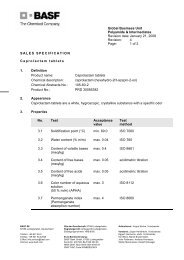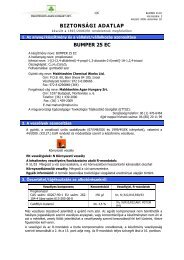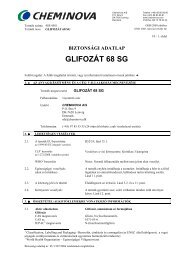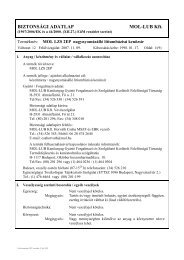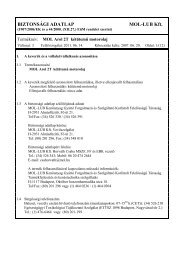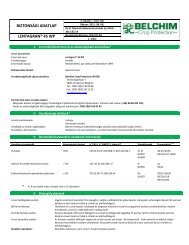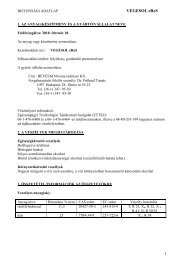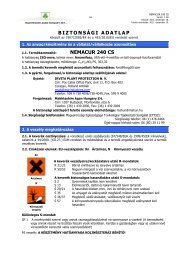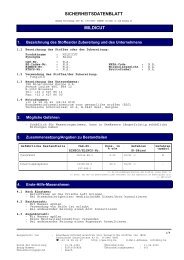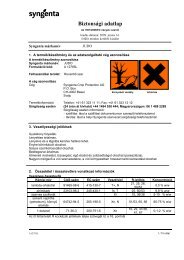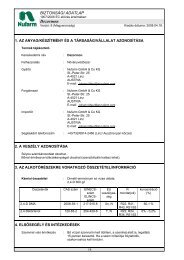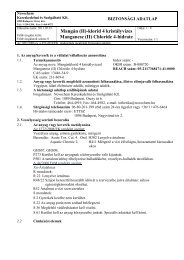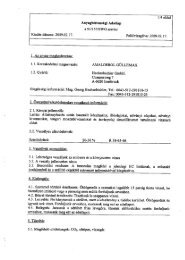MSDS Di-quad.pdf
MSDS Di-quad.pdf
MSDS Di-quad.pdf
You also want an ePaper? Increase the reach of your titles
YUMPU automatically turns print PDFs into web optimized ePapers that Google loves.
Globachem nv<br />
Leeuwerweg 138 • B-3803 Sint-Truiden • BELGIUM<br />
Tel. +32 11 78 57 17 • Fax +32 11 68 15 65<br />
Mobile +32 474 95 13 91 • E-mail: globachem@globachem.be<br />
Web: www.globachem.com<br />
VAT: BE 473.590.226 • H.R. Hasselt: 105.213 • BIC: KREDBEBB<br />
Bank: KBC 735-0020421-39 • IBAN: BE13 7350 0204 2139<br />
Material Safety Data Sheet<br />
Product: DI-QUAD<br />
1. Identification of the substance/preparation and of the company undertaking<br />
Product name<br />
Supplier<br />
DI-QUAD<br />
GLOBACHEM NV<br />
Leeuwerweg 138, 3803 Sint-Truiden (Belgium)<br />
Tel.: +32 (0)11 78 57 17, Fax: +32 (0)11 68 15 65<br />
2. Composition/information on ingredients<br />
Use<br />
Formulation<br />
Herbicide/desiccant<br />
Soluble liquid<br />
Composition/information on ingredients<br />
N° Name CAS N° Content<br />
(%)<br />
Symbol<br />
R Phrases<br />
1 diquat dibromide 85-00-7 37.4 T + , N 22-26-36/37/38-43-<br />
48/25-50/53<br />
3. Hazards identification<br />
Harmful if swallowed.<br />
Toxic by inhalation<br />
Irritation to eyes, respiratory system and skin.<br />
May cause sensitisation by skin contact.<br />
Toxic: danger of serious damage to health by prolonged exposure if swallowed.<br />
Very toxic for aquatic organisms. May cause long-term adverse effects in the aquatic<br />
environment.<br />
4. First aid measures<br />
General<br />
Remove the affected person from source of exposure. Remove all contaminated<br />
clothing and wash affected area.<br />
Ingestion<br />
SPEED IS ESSENTIAL. Seek medical attention immediately. Do not induce vomiting.<br />
Never give anything by mouth to an unconscious person.<br />
Skin contact<br />
Take off immediately all contaminated clothing. Wash skin immediately with water,<br />
followed by soap and water. Such action is essential to minimise contact with skin.<br />
Obtain immediate medical attention. Contaminated clothing should be laundered<br />
before.<br />
<strong>MSDS</strong> DI-QUAD: Version 1.1 06/04/2007 Page 1 / 5
Material safety data sheet<br />
Product : DI-QUAD<br />
Eye contact<br />
Severe damage may be caused by apparently trivial contact and healing may be<br />
delayed. Medical supervision should continue until complete healing has occurred.<br />
Inhalation<br />
Remove patient from exposure, keep warm and at rest. Obtain immediate medical<br />
attention.<br />
GUIDE TO PHYSICIAN – general advice<br />
After ingestion, give up to 1 litre of 15% aqueous suspension of Fuller’s Earth orally or<br />
via gastric tube, together with a suitable purgative (200 ml of a 20% aqueous solution<br />
of mannitol). If ingested, wash out the stomach and test urine for the presence of<br />
diquat. If there is severe mouth ulceration give nothing by mouth until patient’s<br />
condition has improved. Give intravenous fluids only.<br />
5. Fire fighting measures<br />
Suitable Extinguishing Media<br />
For small fires, use foam, carbon dioxide or dry powder extinguishant. For large fires,<br />
use foam or water-fog; avoid use of water jet. Contain run-off water with, for example,<br />
temporary earth barriers<br />
Special Hazards during Fire Fighting<br />
Combustion may generate toxic fumes containing HCl, CO and NO 2 . Under certain<br />
fire conditions, traces of other toxic gasses cannot be excluded.<br />
Protective Equipment for Fire Fighting<br />
A self contained breathing apparatus and suitable protective clothing should be worn<br />
in fire conditions.<br />
Specific methods<br />
Cool containers by spraying with water. Contain fire-fighting water, bunding if<br />
necessary with sand, earth or other inert material.<br />
6. Accidental release measures<br />
Personal precautions<br />
For personal protection see Section 8.<br />
Environmental protection measures following accidents<br />
Pay attention to protective clothing and safety measures.<br />
Sweep up carefully and shovel sweeping into marked bags of drums. <strong>Di</strong>spose of<br />
through a reputable local waste disposal contractor.<br />
7. Handling and storage<br />
Handling<br />
Avoid contact with skin and clothing. Avoid contact with skin and eyes and avoid<br />
inhalation of fog and vapours. Do not eat, drink or smoke while working.<br />
Storage<br />
Store the product in closed original containers.<br />
Storage requirements<br />
Storage Compatibility with other Products: store separate from food and feed.<br />
<strong>MSDS</strong> DI-QUAD: Version 1.1 06/04/2007 Page 2 / 5
Material safety data sheet<br />
Product : DI-QUAD<br />
8. Exposure controls/personal protection<br />
Personal protection<br />
Wear suitable protective gloves when handling the concentrate and when handling<br />
contaminated surfaces. Wash all protective clothing thoroughly after use, especially<br />
the inside of the gloves.<br />
9. Physical and chemical properties<br />
Form:<br />
Colour:<br />
Odour:<br />
liquid<br />
dark red brown<br />
pyridine like<br />
Self ignition point: > 260°C<br />
Fire promoting properties:<br />
pH value: 4 – 5<br />
density:<br />
Solubility:<br />
Flash point:<br />
not explosive<br />
1.2 g/ml<br />
soluble in water<br />
does not flash<br />
10. Stability and reactivity<br />
Chemical Stability Assessment<br />
The concentrated material is corrosive to most metals including zinc, aluminium and<br />
mild steel.<br />
Hazardous decomposition products<br />
Combustion or thermal decomposition will evolve toxic and irritant vapours.<br />
11. Toxicological information<br />
Acute effects of formulated product<br />
Acute oral LD 50 for rats<br />
Acute percutaneous LD 50 for rats:<br />
Inhalation LC 50 (4h):<br />
Skin Irritation (rabbit)<br />
between 200 and 2000 mg/kg<br />
> 2000 mg/kg<br />
0.6 mg/L<br />
Nose bleeding and soreness of the throat may<br />
result from spray mist or dust trapped on the<br />
nasal mucosa. If this occurs review spraying and<br />
handling technique.<br />
mild irritant<br />
Eye Irritation<br />
irritant<br />
Ocular effects (cataracts) have been reported following long term oral exposure of<br />
laboratory animals (rat and dog). This is not considered to be a risk to man when<br />
handled and used as directed on the label.<br />
Skin sensitisation (guinea pig)<br />
diquat may cause an allergic reaction<br />
<strong>MSDS</strong> DI-QUAD: Version 1.1 06/04/2007 Page 3 / 5
Material safety data sheet<br />
Product : DI-QUAD<br />
12. Ecological information<br />
Values for the active ingredient diquat<br />
Toxicity to fish<br />
EC 50 (Cyprinus carpio): 21 mg/L<br />
Toxicity to aquatic invertebrates, Daphnia<br />
EC 50 (Daphnia magna): > 1.2 mg/l (48 h)<br />
Growth Inhibition to Algae<br />
EC 50 (Selenastrum capricornutum – green algae) > 0.26 mg/l (72 h)<br />
13. <strong>Di</strong>sposal considerations<br />
Product <strong>Di</strong>sposal<br />
Contact local authority or a reputable waste disposal company for collection and<br />
disposal of unwanted product or containers.<br />
Container <strong>Di</strong>sposal<br />
<strong>Di</strong>spose of empty Containers in accordance with local regulations.<br />
14. Transport information<br />
ADR / RID / ADN / ADNR / IMDG / ICAO / IATA / DGR<br />
UN 1760<br />
Corrosive liquid, n.o.s. (diquat mixture)<br />
Class 8<br />
PG: III<br />
15. Regulatory information<br />
Hazard symbol<br />
T<br />
N<br />
R(isk) phrase(s)<br />
R 22:<br />
R 23:<br />
R 36/37/38:<br />
R 43:<br />
R 48/25:<br />
R 50/53:<br />
Toxic<br />
Dangerous for the environment.<br />
Harmful if swallowed.<br />
Toxic by inhalation<br />
Irritating to eyes, respiratory system and skin.<br />
May cause sensitisation by skin contact.<br />
Toxic: danger of serious damage to health by prolonged exposure if<br />
swallowed.<br />
Very toxic for aquatic organisms. May cause long-term adverse effects<br />
in the aquatic environment.<br />
S(afety) phrase(s)<br />
S 2: Keep out of reach of children.<br />
S 13: Keep away from food, drink and animal feedstuffs.<br />
S 20/21: When using, do not eat, drink or smoke.<br />
S 25: Avoid contact with eyes.<br />
S 28: After contact with skin, wash immediately with water.<br />
S 35: This material and its container must be disposed of in a safe way.<br />
S 36/37: Wear suitable protective clothing and gloves.<br />
S 45: In case of accident or if you feel unwell seek medical advice<br />
immediately (show this label where possible).<br />
S 57: Use appropriate containment to avoid environmental contamination.<br />
<strong>MSDS</strong> DI-QUAD: Version 1.1 06/04/2007 Page 4 / 5
Material safety data sheet<br />
Product : DI-QUAD<br />
16. Other information<br />
All information and instructions provided in this <strong>MSDS</strong> are based on the current state<br />
of scientific and technical knowledge and are presented in good faith and believed to<br />
be correct.<br />
<strong>MSDS</strong> in accordance with directive 2001/58/EC.<br />
This information applies to the product. In case of formulations of mixes, it is<br />
necessary to ascertain that a new danger will not appear. It is the responsibility of<br />
persons in receipt of this <strong>MSDS</strong> to ensure that the information contained herein is<br />
properly read and understood by all people who may use, handle, dispose or in any<br />
way come in contact with the product.<br />
Library of risk phrases mentioned in paragraph 2 and not in paragraph 15:<br />
R26: Toxic by inhalation<br />
<strong>MSDS</strong> DI-QUAD: Version 1.1 06/04/2007 Page 5 / 5



